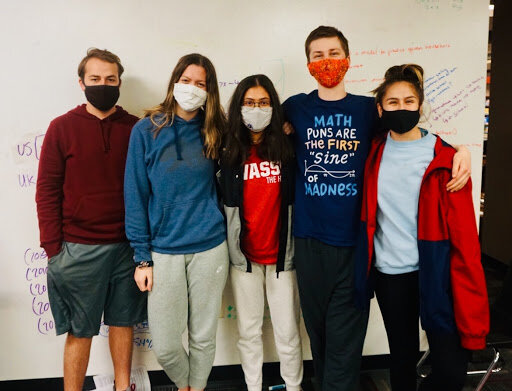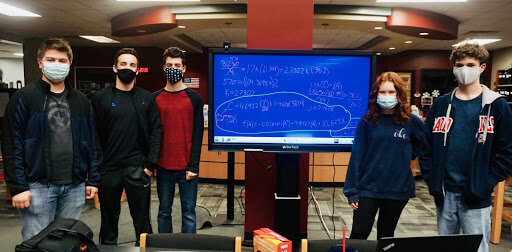MathWorks Modeling Challenge
By Aidan Rodriguez
On Sunday, March 28, two groups of students that are passionate about math competed in a nationwide math competition. The two teams (one a junior team, and the other a senior team) representing Owasso High School were composed of five students each.
The senior team (From left to right) Anthony Cammuso, Emma Russell, Shreya Rohatgi, Merrik Barnes and Aidan Rodriguez. (All photos were taken by Aidan Rodriguez)
In this competition, students are presented with a real-world problem that they are supposed to find a mathematical model posing a solution/prediction. Every year, MathWorks tries to come up with questions that are relevant to what is happening in the world today, and this year was no exception. The questions this year focused on internet bandwidth due to COVID-19 and the increase of internet usage as of late.
Teams work for fourteen hours to solve three questions, then write a paper explaining their findings. Because the challenge is so long, food and brain breaks are a must. This may seem like an exhausting process, and it is; however, the students who participated in the challenge loved the experience.
A member of the senior team who also participated last year, Anthony Cammuso, explains that he returned this year to improve his performance from last year. He also came back because he enjoyed the collaboration with other students. It may sound cliche, but it’s true. During this competition, you learn to lean on your teammates and play to your strengths. They help you with the things you don’t know and vice versa.
Cammuso states, “I'd say [my favorite part was] collaborating with others and trying to solve a problem that doesn't have a clear-cut answer. Especially in high school, it's just not something [we] students get to do very often.”
The junior team (From left to right) Caleb Tietz, Ronald “Ronnie” Walker, Toby Richards, Margaret “Maggie” Wall and John “Jack” Hicks
Junior team member Maggie Wall agrees with Cammuso claiming, “I thought it was really fun… The prospect of getting in a room and doing math for fourteen hours doesn’t seem fun to me, but the collaboration aspect was very fun. Working with a team was really cool; it was fun reaching these conclusions together and to reach those goals of figuring it out together.”
The biggest challenge of this experience is simply getting started. It’s a daunting task for students to attack, especially at seven in the morning. For the first hour or so, both teams studied the data they were given and did some outside research on the topic.
Wall discusses her team’s approach to the questions “For the first hour, we didn’t really understand them, so we just stared at them until we understood. Then after a little while, we started to make a few conclusions from the information that we had [and] doing research.”
The experience may not sound that appealing to most students, but Cammuso explains, “Despite how atrocious spending 14 hours on a math problem sounds, it's actually pretty enjoyable. It feels like you're offering a genuine solution to a real-world problem, which, once again, isn't something you get to do in high school very much, if at all.”
This may not interest everyone, but if it sounds like something you would like to try, Mrs. Zamor hosts it every year. She is always looking for students who are willing to go outside of their comfort zone and challenge themselves. Give it a try, and you may end up loving it!

